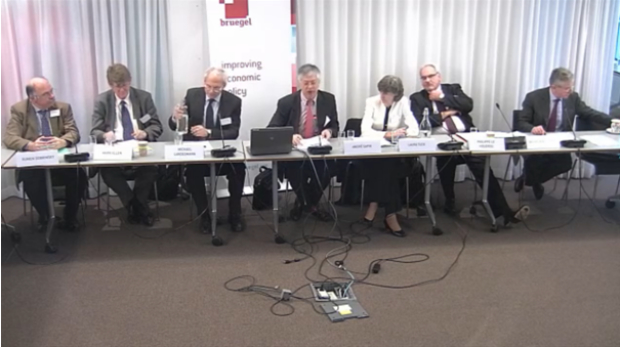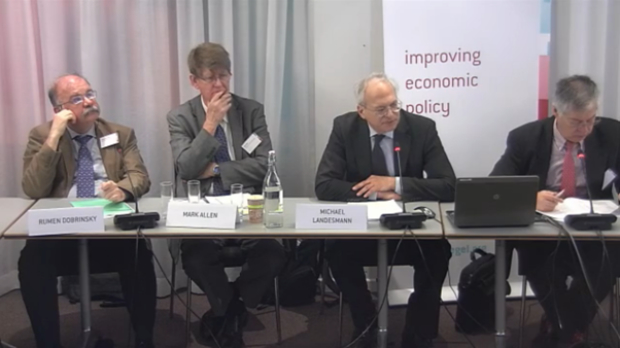How can development banks best support growth in CESEE?
16 June 2015
wiiw Scientific Director Michael Landesmann and wiiw Research Associate Rumen Dobrinsky discussed the IFI’s Joint Action Plan for Growth in CESEE at the Brussels Think-Tank Bruegel
On 2nd June 2015, Bruegel welcomed the vice-presidents of the European Investment Bank, the European Bank for Reconstruction and Development and the World Bank, together with guests from the Vienna Institute for International Economic Studies for a discussion of the three development banks' recent Joint IFI Action Plan (JIAP) in Central, Eastern and South Eastern Europe (CESEE).
As the financial crisis became a longer recession, it was soon clear that CESEE was especially vulnerable. More than a decade of convergence with the richer economies to the west was at risk, as sluggish export markets and frozen credit lines suppressed CESEE's potential for growth. To shore up the economy and lay the ground for a return to sustainable long-term growth, the three international development lenders renewed their efforts to provide loans across the region. They coordinated support for projects such as infrastructure investment, financial market stabilisation and credit guarantees for SMEs.
Mark Allen (adviser on CESEE matters, European Investment Bank) presented the recent “Final Report on the Joint IFI Action Plan (JIAP) for Growth in in Central and South Eastern Europe”. Vice-presidents Philippe Le Houérou (EBRD), Wilhelm Molterer (EIB) and Laura Tuck (World Bank) followed up on the report. Rumen Dobrinsky (Vienna Institute for International Economic Studies) and Michael Landesmann (Vienna Institute for International Economic Studies) commented, while André Sapir (Bruegel) chaired the event.
The event started with a presentation of the Final Report by Mark Allen. Firstly he pointed out that, under the Joint IFI Action Plan for Growth, the EIB, the WB and the EBRD announced assistance over 2013-14 to CESEE of at least 30bn EUR, and the actual assistance exceeded 42bn EUR. Secondly, he explained that the main aim was to support growth in the region, which nevertheless remains subdued compared to pre-crisis developments due to weak economic recovery in the euro area (the region’s main trading partner), and the continuing deleveraging of cross-border banking. In this respect, lending under the JIAP has been of major significance. In particular, funding of local banks, together with guarantees, has allowed the maintenance of credit supplies to SMEs. The absorption capacity of EU funds was improved too. Thirdly, most funds provided under the JIAP aimed at improving the infrastructure of the region, ie European transport, energy and communication networks. Coordinated assistance also strengthened financial systems, and raised productivity of firms, with an increased use of innovative financial instruments to render projects less risky for private investors. Finally he concluded that JIAP has succeeded in helping the CESEE region return to growth. However, looking forward convergence seems to have stalled (especially in the Western Balkans). Poor demographics, weak institutions and productivity are further challenges to be tackled.
The three vice-presidents followed up by highlighting the good results of cooperation between their institutions throughout the programme, a best practice to be taken to the future. Ms Tuck from the World Bank discussed the main challenge looking ahead: how to get back to growth and convergence. She highlighted that the CESEE region is the global region exhibiting the weakest growth rates, exhibiting a public debt constrains, high unemployment and a substantial ratio of non-performing loans. In such an environment, competitiveness for jobs is crucial (creating a supportive business environment and fostering labour market participation). Mr Le Houérou gave the EBRD’s take on the region, saying that much lower growth rates will be the new normal. Mr Molterer from the EIB pointed out that JIAP was mainly about deleveraging, and how to avoid a credit crunch in the region.
Also, the outlook is not too rosy. The EIB addressed those issued firstly through a sufficient operation capacity, keeping their level of financing the same over 2015-17, and secondly by adopting a supportive and advisory role when it came to stabilising the functions of the respective financial sectors in the region. Recently, a shift from lending to more risk bearing instruments can be observed.
Mr Dobrinsky was the first discussant from the Vienna Institute for International Economic Studies. He found that the JIAP can be seen as an overall successful programme, since it provided much needed financial flows, was timely and generous and fostered cooperation among the three banks. However, he also noted that an overall assessment is still hard to make, ie the effectiveness and quality of the project implementation was not addressed.
Also, the study’s target was growth, but should the pre-crisis growth based on an unsustainable model be repeated? The second discussant, Mr Landesmann, highlighted that a region-wide approach is needed, as opposed to a country-specific approach promoted up until now by the three banks. Especially when considering the different stages of development in the region, e.g. in terms of export performance, CEE have been able to plug themselves into a European value-chain, while the Balkans are still lagging behind. This could be addressed through investment in a rail network across the region (not only in single countries).


